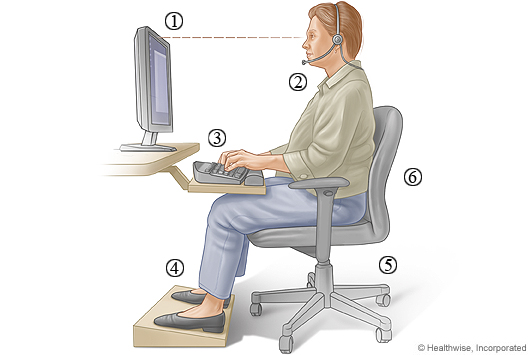Ergonomic Workstation

This is one example of an ergonomically correct workstation. Some people would be more comfortable with slight adjustments such as tilting the keyboard a bit or removing the armrests from the chair. But this picture shows many of the important pieces of a good workstation.
- The top of the monitor screen is at eye level.
- A telephone headset helps you to avoid awkward positions while talking and doing other tasks, such as typing.
- A wrist pad at the bottom of the keyboard helps keep the wrists in a neutral, almost straight position during brief rests from typing. Wrist pads are not designed to be used while you type. But some people find the pads helpful even when they are using their keyboard or mouse. When you type or use your mouse, try raising your forearms a little so your wrists are in a neutral position and your arms and hands can move freely. If you have arm rests on your chair, you may be able to adjust them so your forearms are parallel to the floor and your wrists are neutral. You may want to alternate between resting your wrists on the pads and raising them up. If you use a wrist pad, it's best to rest your palm or the heel of your hand on the support, rather than your wrist.
- If your feet do not rest flat on the floor when you sit in your chair, a footrest raises your feet to reduce pressure on the lower back.
- Armrests are adjusted so that the elbows are close to the side of the body and bent at an angle between 90 and 100 degrees.
- An adjustable chair has a height adjustment to allow the feet to rest on the floor or on a footrest. Also the back of the chair adjusts for different positions.
Sitting with the ears directly above the shoulders, which in turn are over the hips, helps prevent back strain. Placing a lumbar pillow or roll against the small of the back provides extra support.
Current as of: July 31, 2024
Author: Ignite Healthwise, LLC Staff
Clinical Review Board
All Healthwise education is reviewed by a team that includes physicians, nurses, advanced practitioners, registered dieticians, and other healthcare professionals.
This information does not replace the advice of a doctor. Ignite Healthwise, LLC, disclaims any warranty or liability for your use of this information. Your use of this information means that you agree to the Terms of Use. Learn how we develop our content.
